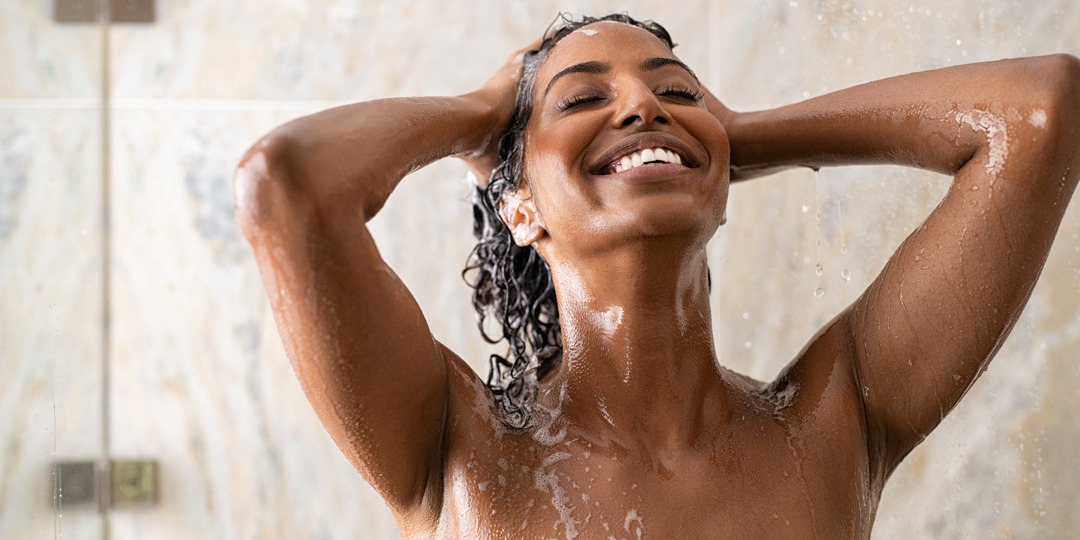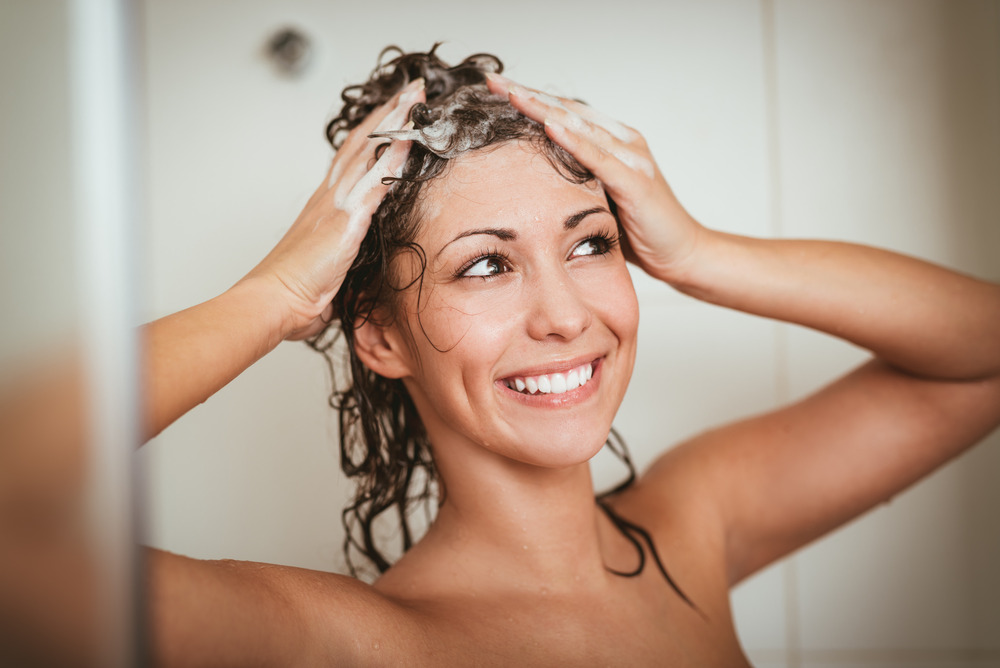
In the endless pursuit of silky, manageable, and vibrant locks, understanding how to wash your hair correctly can be a game-changer. Surprisingly, there’s more to it than rinse, lather, and repeat.
From the temperature of the water to the choice of products, each step is crucial. So, let’s delve into the intricacies of keeping your hair healthy and lustrous!
Is There a Right Way to Wash Hair?
Absolutely! Washing your hair properly can preserve the natural oils and protect the hair cuticle, resulting in healthier and more resilient locks. Different hair types, be it color-treated hair, fine hair, oily hair, or dry hair, require unique approaches.
However, certain foundational practices apply universally, ensuring that your mane receives the care it deserves.
How to Wash Your Hair The Right Way
1. Soak Hair with Warm Water Before Shampooing
Preparing your hair with a thorough wetting process using warm water is essential. It’s a gentle method that ensures the hair cuticle opens up, making it easier to cleanse away dirt, excess oil, and any lingering product residue.
This process is crucial across all hair types because it preps the hair for effective cleansing without excessively stripping it of its natural oils, which are vital for maintaining hair health and texture.
Detailed Step by Step Instructions:
Step 1. Start by setting your shower to a warm, comfortable temperature. It’s essential not to use hot water, as it can lead to damage and irritation, while cold water won’t be as adequate in opening the hair cuticles.
Step 2. Position yourself under the water, ensuring it saturates every part of your hair, from the roots to the tips. It’s essential that your hair is soaking wet, which could take a couple of minutes, especially for longer or thicker hair types.
Step 3. Use your fingers to massage your scalp and hair under the water gently. This preliminary action helps loosen up any excess oils and product residues, prepping your hair for shampooing.
2. Start Shampooing at the Roots
Focusing the application of shampoo at the roots is a strategic method that targets the primary area of oil and residue build-up. Whether you’re using a clarifying shampoo for a deep cleanse or a gentle shampoo for regular maintenance, this technique ensures the scalp receives the attention it requires without the lengths and ends of the hair being stripped of their natural moisture.
This approach is essential for every hair type. It is incredibly considerate for those with color-treated hair or bleached hair, as it cleanses while safeguarding against undue dryness or color degradation.
Detailed Step-by-Step Instructions:
Step 1. Once you thoroughly wet your hair, take a dime-sized amount of your chosen clarifying shampoo or gentle shampoo, depending on your hair type and cleansing needs, and spread it onto your palms by rubbing your hands together.
Step 2. Begin applying the shampoo to your scalp, starting from the front and moving towards the back. Concentrating on the roots is essential, the area most prone to accumulating oil and dirt.
Step 3. With your fingertips (avoid using your nails), delicately massage the shampoo into your scalp using a circular motion. This method is suitable for all, ensuring the shampoo penetrates effectively without causing any damage to the scalp or hair.
Step 4. Allow the lather to move down your hair lengths during the rinse. Avoid the urge to scrub the ends or pile your hair on top of your head; the flowing shampoo will be sufficient to clean the lengths of your hair.
3. Scrub Your Scalp—Not Your Hair
The key to an effective hair-washing process is gently scrubbing the scalp, not the hair. Vigorous hair washing, especially for those with long hair length, can lead to tangles and breakage, often resulting in frizzy hair.
Focusing the cleansing action on the scalp helps to remove dirt and excess oils where they primarily accumulate, ensuring a clean, fresh feel without damaging the hair strands.
Detailed Step by Step Instructions:
Step 1. After applying your shampoo, gently use the pads of your fingertips to massage the product into your scalp. Refrain from using your nails or scrubbing too hard, which can irritate your scalp or harm your hair.
Step 2. Work in small, circular motions around your entire scalp. This method stimulates blood flow and aids in the removal of built-up products, oils, and skin cells.
Step 3. Avoid bunching up or vigorously rubbing your hair, especially if you have longer or medium-length hair.
Step 4. The shampoo running down your strands during rinsing is enough to clean them without rough manipulation, which can cause breakage and frizz.
4. Rinse and Repeat if Necessary:
Concluding the hair-washing process with a comprehensive rinse is essential. However, for specific hair types, especially those susceptible to excessive oiliness or substantial product usage, one cycle of shampooing might not be adequate.
Repeating the shampooing process ensures that all residual dirt and sebum are effectively removed. Whether you’re using a moisturizing shampoo for drier textures or a regular one for normal hair, the decision to repeat the process should be dictated by personal necessity, not a universal standard.
Detailed Step-by-Step Instructions
Step 1. Thoroughly rinse your wet hair with warm water, making sure that all the shampoo is flushed out. You’ll know the shampoo is entirely washed away when your hair begins to “squeak” under your fingers.
Step 2. Assess your scalp and hair. If your scalp retains an oily sensation or your strands don’t feel exceptionally clean, it’s prudent to proceed with a second shampoo application. This situation is commonly encountered by individuals who utilize numerous hair products, experience significant oiliness, or have a lengthy hair-washing process due to washing infrequently.
Step 3. For the second shampoo, you do not need to use as much as you did initially. A smaller quantity is generally sufficient, considering your hair is already somewhat cleansed from the first wash.
Step 4. After the second application, make sure to rinse your wet hair thoroughly to ensure no shampoo remains. It’s crucial to eliminate all traces of shampoo to avoid residue build-up, which can lead to hair looking dull and lifeless.
5. Rinse Shampoo Thoroughly
Properly rinsing shampoo from your hair is a pivotal step in keeping your hair healthy. Residual shampoo can lead to scalp irritation and dryness, hindering hair growth.
By ensuring that all shampoo is washed out, you’re not only maintaining the health of your hair cuticle but also preserving the natural balance of oils necessary for a vibrant, strong mane, regardless of hair texture.
Detailed Step-by-Step Instructions:
Step 1. With your hair cuticle softened from the warm water and shampoo, it’s time to rinse. Tilt your head back and let the water run from the roots to the ends, ensuring every strand is covered.
Step 2. Use your fingers to gently comb through your hair, from the scalp to the ends. This helps to dislodge any lingering shampoo, which is particularly important for those with fine hair, as residue can weigh it down.
Step 3. Continuously assess while you rinse. If your hair still feels slippery or soapy, continue rinsing. It’s crucial to remove all shampoo, especially for colored hair, to prevent fading and maintain moisture levels.
Step 4. A final check involves lightly squeezing the water out of your hair and feeling for any slipperiness that indicates remaining shampoo. Ensure there’s none left to keep your scalp and hair residue-free.
6. Apply Conditioner on the Bottom Half of the Hair
Applying conditioner to the bottom half of your hair hydrates and nourishes your strands where they’re most vulnerable to damage without overburdening your roots, making your scalp appear oilier. This method protects the hair cuticle, especially in colored hair, by providing moisture and nutrients essential for maintaining hair strength, elasticity, and shine, facilitating easier management regardless of hair texture.
Detailed Step-by-Step Instructions:
Step 1. After you’ve managed to properly wash and rinse out the right shampoo, squeeze out the excess water from your hair. Too much water remaining in your hair can dilute the conditioner, reducing its effectiveness.
Step 2. Apply the conditioner, starting midway down your hair and working toward the ends. The bottom half of your hair is older and usually more damaged, requiring more attention and care.
Step 3. Use a wide-toothed comb or your fingers to gently distribute the conditioner through the bottom half of your hair. This ensures every strand benefits from the conditioner, which is vital for maintaining a smooth hair texture and promoting hair growth.
Step 4. Let the conditioner sit for the prescribed time on the bottle. This allows sufficient time for the active ingredients to penetrate and nourish the hair cuticle.
Step 5. If you have an oily scalp, avoid applying conditioner to the roots, which can exacerbate the issue. Instead, focus on the tips that need the most hydration and repair.
7. Rinse Conditioner with Cold Water
Rinsing conditioner with cold water plays a crucial role in achieving healthy hair. Cold water helps seal the hair cuticle, making it lay smooth, increasing shine, reducing frizz, and preventing hair breakage. This practice is particularly beneficial for coarse hair, which tends to absorb moisture quickly but loses it just as easily.
By sealing moisture inside, cold water ensures your hair maintains its hydration, promoting a healthy scalp and more manageable hair regardless of type.
Detailed Step-by-Step Instructions:
Step 1. After allowing the conditioner to absorb into your hair for the recommended duration, it’s time to rinse. Instead of lukewarm water, which you use to wash your hair, switch to cold water for this step. The chill might be a little uncomfortable, but the benefits for your hair are substantial.
Step 2. Tilt your head back and let the cold water run through your hair, from the roots to the tips. Ensure the water flow isn’t too harsh to prevent tangles and potential hair breakage.
Step 3. Use a wide toothcomb or your fingers to detangle your hair while you rinse gently. This method helps remove all conditioner traces without causing breakage, which is especially important for coarse hair.
Step 4. Continue to rinse until your hair feels clean and not slippery or slimy. Slick hair might indicate that conditioner remains, which can lead to a build-up and dull-looking hair.
Step 5. Once you’re done, gently squeeze the excess water from your hair. Avoid wringing your hair, as this can cause damage to the hair cuticle, leading to frizz and breakage.
Common Mistakes of Washing Hair

Taking care of your hair can be tricky; sometimes, we make mistakes without realizing it. Here are seven critical missteps you might be making, unknowingly compromising the health and beauty of your locks.
1. You shampoo too often or need more.
2. You OD on dry shampoo.
3. You’re not entirely wetting your hair first.
4. You massage too hard.
5. You’re shampooing the ends.
6. You’re not shampooing long enough.
7. You use the same shampoo year-round.
Knowing what not to do is just as crucial. Avoid washing your hair daily, as it can strip away natural oils, leading to dryness and breakage.
Moreover, please refrain from using hot water, as it can damage the hair, especially color-treated hair. Finally, remember not to apply conditioner on the scalp, particularly for those with oily hair, as it can exacerbate the issue.
Don’t Wash Your Hair Every Day

Contrary to popular belief, daily washing can be detrimental, stripping your hair of its natural oils and leading to a dry, itchy scalp that is more likely to break. Adjust the frequency of your hair washes depending on your hair type and lifestyle.
For example, fine hair and oily hair may require more frequent washing, while dry hair and color-treated hair benefit from less.
Bottom Line
Proper hair washing combines art and science, requiring the right techniques and products. By understanding your hair type, choosing suitable shampoos and conditioners, and following the steps outlined, you can transform the mundane task of washing hair into an act of self-care.
Remember, the aim is to keep your hair clean, nourished, and vibrant without over-stripping natural oils or causing damage. Investing in quality products is essential to maintain the health and vibrancy of your locks.
In Vitamins Revive offers a range of products designed to keep your hair nourished, strong, and manageable. There’s something for every hair type and concern, from shampoos to conditioners and dry shampoo alternatives.
FAQ’s
How do you know if you washed your hair correctly?
If your hair feels clean, smooth, and not overly oily or dry after drying, you’ve likely washed your hair correctly. The absence of product residue and an itch-free scalp are also good indicators.
How often should I wash my hair?
There’s no one-size-fits-all answer. The frequency depends on several factors, including your hair type, lifestyle, and the level of oil production. Oily hair types must be washed every other day, while dry hair types do well with once-a-week washing.
How do you wash your hair like a professional?
Professionals recommend thoroughly wetting your hair, using the right amount of shampoo, and applying it with a gentle massage to the scalp. Always condition, focusing on the ends, and finish with a cool rinse to seal the hair cuticle.
Consider consulting a professional hair stylist co for expert advice tailored to your needs.










